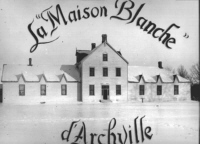

| Project Information |
| History |
| Mainstreeter |
| Churches |
| Scholasticate |
| Schools |
| Railways |
| Notables |
| After 1907 |
| 1901 Snapshot |
| Air Photo Study |
| Image Library |
| Databases |
| Search |
|
The Oblates and Ottawa The first Oblate to arrive in Ottawa in June of 1844 was Fr. Adrien Telmon from Montreal. By September of 1848 he, along with fellow Oblate Joseph Eugene Bruno Guigues (the first Bishop of Ottawa) had established St. Joseph’s College. This was a small wooden structure located near the site of the present-day Notre Dame Cathedral. Initial enrolment was comprised of 60 French and English speaking young men (3). Civilly incorporated in 1849, the College of Bytown became the College of Ottawa in 1861; and in 1866 received the rank of university. The first Bachelor degree was granted in 1872 (4). |
|
The Two Solitudes Emerge From the outset, the College of Ottawa (University in 1889 (5))
was intended to serve the needs of both English and French Catholics.
The driving force behind this philosophy came from Fr. Joseph-Henri Tabaret
(1828 – 1886), "a man of vision, courage and great common sense"
(6). To most, he is thought of as the true
founder of the university as he |
| To understand the scope of the impending controversy it is necessary to briefly examine the demographic and linguistic history of the two opposing Catholic groups. | |||||||||||||||||
 French-speaking
Oblates were comprised of those from France and also those from Quebec who,
as H. A. MacDougall describes in his history of St. Pat’s, were "burdened
by a tradition . . . (of) a theocratic political system in the Province
of Quebec" (8). This latter group saw
the language issue as a threat to the preservation of a cultural identity
(exactly as it is today!). To Oblates from Quebec, French language education
was both constitutionally guaranteed and a cultural right. They fervently
supported a bilingual university. French-speaking
Oblates were comprised of those from France and also those from Quebec who,
as H. A. MacDougall describes in his history of St. Pat’s, were "burdened
by a tradition . . . (of) a theocratic political system in the Province
of Quebec" (8). This latter group saw
the language issue as a threat to the preservation of a cultural identity
(exactly as it is today!). To Oblates from Quebec, French language education
was both constitutionally guaranteed and a cultural right. They fervently
supported a bilingual university. |
|||||||||||||||||
| On the opposing side were the anglophone Oblates of mainly Irish descent. Prior to the arrival of the Oblates in Canada, they had developed a strong following in Ireland. It was understandable then that many of the Oblate priests who came to Canada would be of the Irish persuasion and "deeply scarred by memories of centuries of official oppression in an Irish homeland" (9). As well the massive Irish emigration to Canada beginning in the 1840’s swelled the Ontario Catholic community. | |||||||||||||||||
| Elliott notes in "The City Beyond"(10) that the 1861 Nepean census shows that almost 77% of the 658 heads of households were of Irish origin. In terms of Catholics, of the 287 households listed as such, 249 (86.7%)were of Irish descent and 38 (13.2%) were French Canadian. Nepean was therefore decidedly Irish. |  |
||||||||||||||||
|
This was not the case in Lower Town and east of the Rideau Canal in places such as Sandy Hill, Janeville and Gloucester Township. A comparison of French and Irish Roman Catholics from 1859 shows an ever widening gap between these two ethno-religious groups. According to Taylor in his book "Ottawa – An Illustrated History" (11), the following is revealed:
The 1891 census manuscript for Ottawa East shows that there were 293 residents identified as being Roman Catholic. Using the 1871 and 1901 censuses to that lists heritage, it was possible to identify 111 as being of Irish origin and approximately 172 as being of French-Canadian origin. There were a few others who listed Scottish or English origin. The ratio for Ottawa East therefore is 1.55:1 for French to Irish Catholics. A detailed analysis of the 1901 Census for Ottawa East can be found here. By 1913, Ottawa’s total population was approximately 100,000 people, with "c. 26,000 French and c. 14,000 English Catholics (12). An example of a reflection of this community structure in the 1940's and 50's can be seen here. |
|||||||||||||||||
| The pronounced increase in French Catholics was of great concern to Irish Catholics as they felt "a threat to the quality of education and hence to the existence of a separate school system which was regarded as essentially English" (13). Further complicating the issue were the Oblates from France who "wanted to adopt English as the only teaching language" (14) at the University. | |||||||||||||||||
| In 1874, English became the official language of the College, a policy that remained until 1901. But under the wise stewardship of the Superior (Rector) of the College, Fr. Tabaret and the support of Bishop Guigues and later Bishop Joseph-Thomas Duhamel, the bilingual character of the institution was maintained. In 1901 however, the issue of language again emerged and this produced a split in the Oblate Order and ultimately, the building in 1929 of St. Patrick’s College in Ottawa East. | |||||||||||||||||